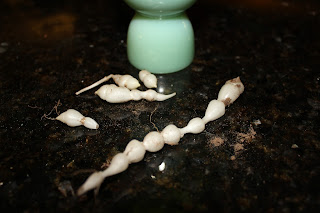Summertime seems a long way off, but now is a great time to start thinking about how you're going to handle those big harvests of fruits and veggies. Dehydrated cherries are a favorite in our family for lunchbox snacks and energy on the go. Now is the time of year to pull out your dehydrator, make sure it's in good working order, and wash all the trays if you didn't last fall.
My American Harvest Snackmaster Elite has served me well over the last 20 years, but I'm secretly yearning for an Excalibur. This might be the year...
In most parts of the United States, summer means cherry
season. The farmer’s markets and grocery stores are filled with bins of red,
black and bing cherries and it is practically impossible to not pick some more
up on each visit.
Cherries are a good candidate for preserving and there are
many ways to do that including canning and freezing. The easiest method,
however, is drying them in a food dehydrator. They will last for at least a
year in a dark cupboard or practically indefinitely in the freezer.
How to
Dehydrate Cherries
Start with the freshest cherries you can find in season. The
skin should be shiny with no dimpling or wrinkling. Avoid cherries with many
scars or scabs. These likely sustained hail damage during their growth and will
not last as long dehydrated.
Wash the cherries thoroughly with a small amount of dish detergent
dissolved in cool water, then rinse with plain water. Allow the cherries to dry
in a colander or laid out on a clean dish towel. The wetter the cherries are,
the longer they will take to dehydrate.
There are two ways of preparing cherries for the dehydrator.
If you own a cherry stoner, you can use that to push the stones out. Then, cut
each cherry in half and arrange on a dehydrator tray cut side up.
Alternatively, you can simply cut the cherries in half to the stone, then
remove the stone. Using a stoner really does not save significant time here, so
keep it simple.
Dehydrate for 10-12 hours, checking close to the end for
doneness. The dried cherries should be leathery, neither wet nor crisp. If your
dehydrator does not have a fan to circulate the warm air, rotate the trays half
way through to make sure that the cherries are drying at the same rate.
Store the dehydrated cherries in a clean dry Mason jar with
a tight-fitting lid. Keep in a dark cupboard or in the freezer.
Rehydrating
Dried Cherries
There are several ways to rehydrate cherries, depending on
the application. For muffins and other baking, it is not necessary to rehydrate
the cherries at all- they have the consistency of raisins. For other baking or
ice creams and sauces, rehydrate in warm water or orange juice until the
cherries are plump and soft. Drain before using. For more adult cherries, rehydrate in Grand
Marnier or dark rum.
Uses
for Dehydrated Cherries
Once cherries have been fully rehydrated, they can be used
almost anywhere you would use fresh cherries. They are especially good over ice
cream or made into a sauce to top cheesecake.

.jpg)



.JPG)



